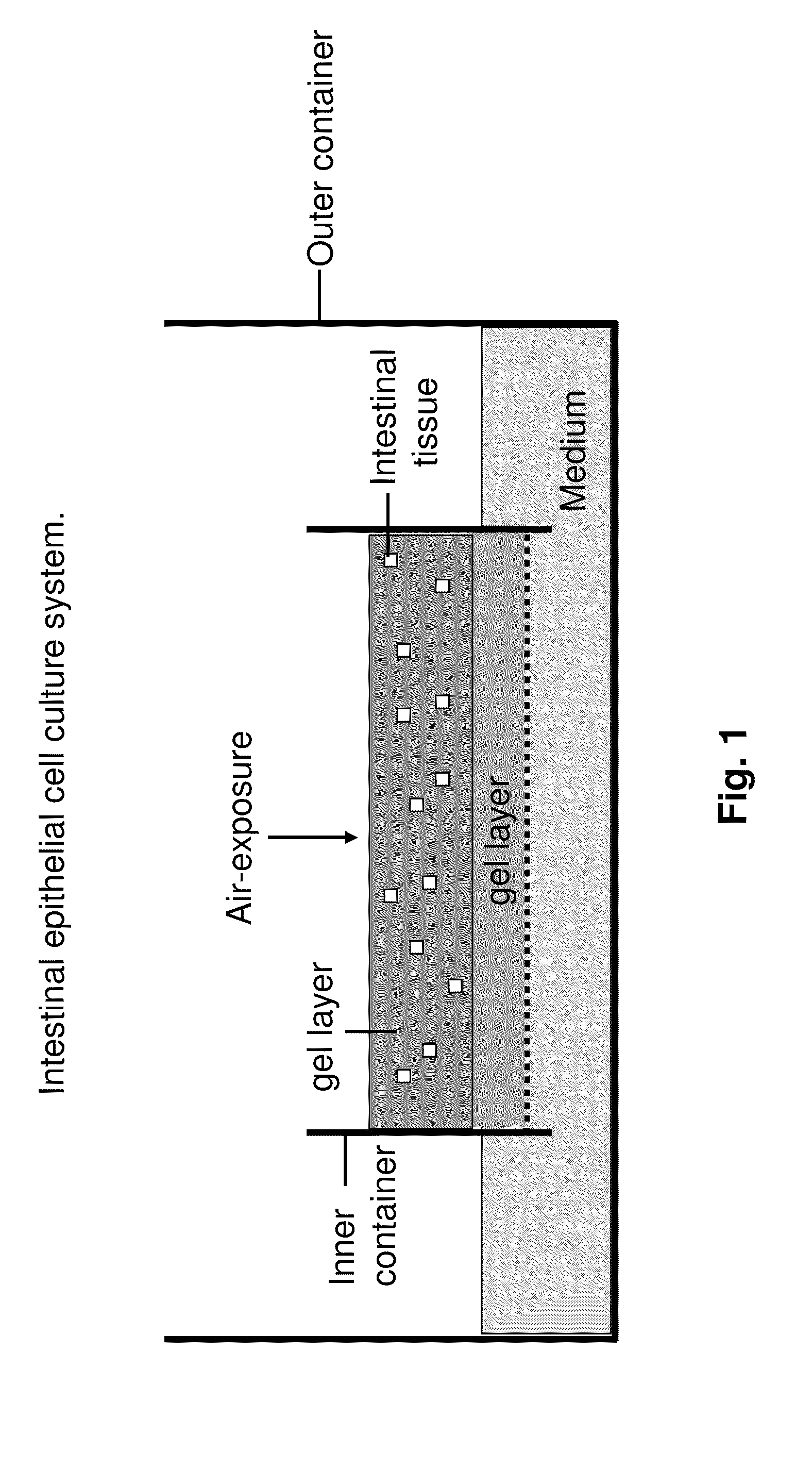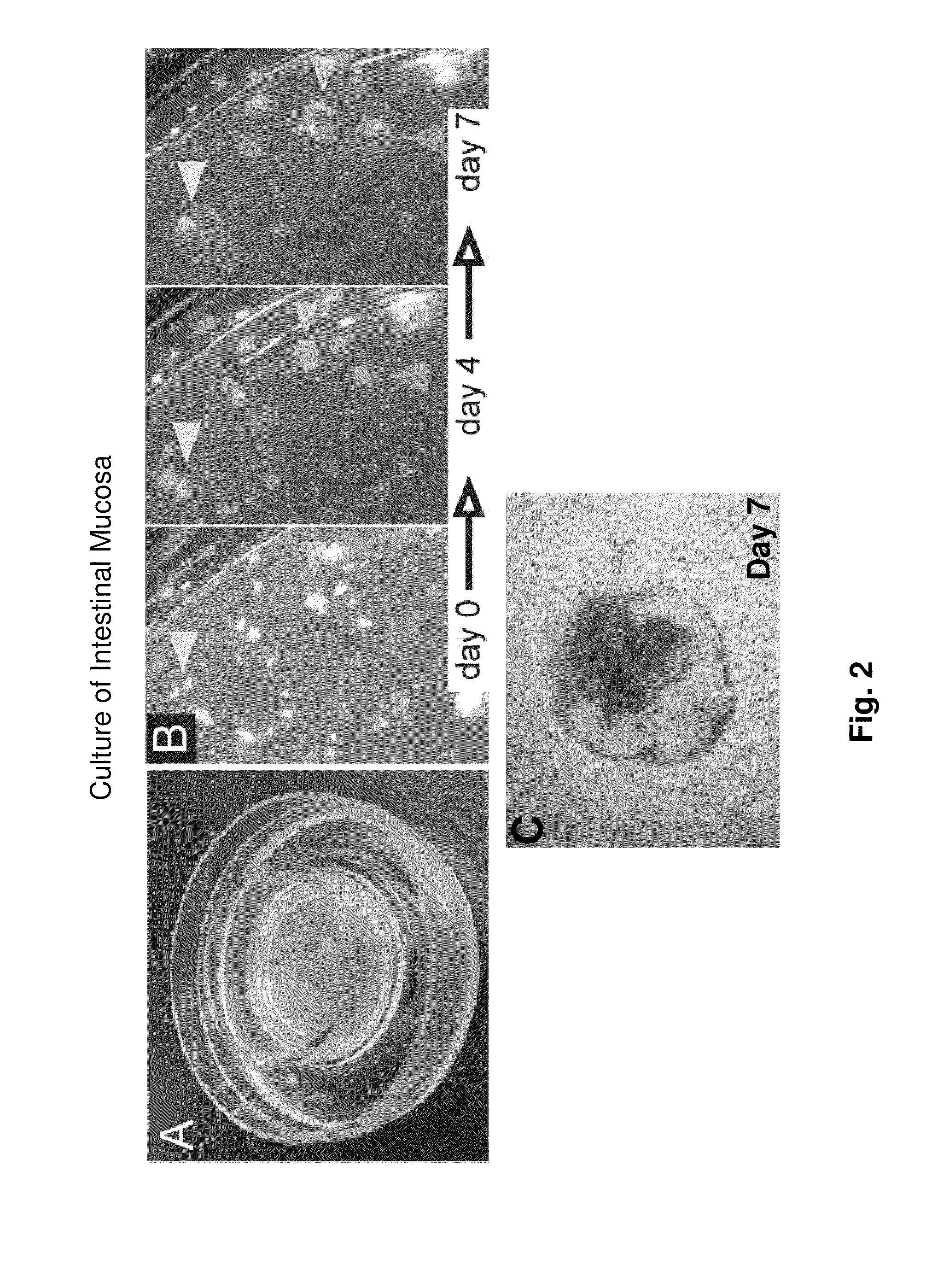Ex Vivo Culture, Proliferation and Expansion of Intestinal Epithelium
a technology of intestinal epithelium and ex vivo culture, which is applied in cell culture active agents, artificial cell constructs, instruments, etc., can solve the problems of severe deficiencies in physiologic intestinal function and effective intestinal failure, inability to robustly inability to establish procedures that allow robust ex vivo expansion of intestinal epithelium or stem/progenitor cells, etc., to achieve the effect of alter
- Summary
- Abstract
- Description
- Claims
- Application Information
AI Technical Summary
Benefits of technology
Problems solved by technology
Method used
Image
Examples
example 1
Culture of Intestinal Explants
[0106]Provided herein is a tissue culture system for long-term culture of explants of murine small or large intestine. Explants cultured by this method exhibit long-term proliferation, multi-lineage differentiation, preservation of cellular ultrastructure and differentiation markers characteristic of absorptive enteroytes, goblet cells and enteroendocrine cells.
[0107]Small intestine or colon of C57Bl / 6J mice is procured under sterile conditions, minced and mixed with type I collagen gel. Subsequently, these explant containing gels are poured onto transwell cell culture inserts with a collagen gel layer. Transwell cell culture inserts are available commercially from a number if resources e.g. Corning, Signaaldrich. These cell culture inserts are placed into secondary outer dishes containing HAMs F-12 with 20% FCS. Examples of cystic structures formed by this culture method and cultured for more than 100 days are shown in FIG. 3. Proliferation and histolo...
example 2
Coculture of Human Embryonic Stem Cells with Intestinal Cell Culture
[0111]Screening of candidate cells for the presence of intestinal stem cells or for cells with ability to adopt intestinal stem cell fate is performed using human embryonic stem (hES) cells as candidate cells. The intestinal explants cultured by methods of example 1 reproduce the in vivo Wnt-dependency of intestinal proliferation (i.e. stimulation by RSpo1 and inhibition by Dkk1 / Fz8-Fc), suggestive of accurate recapitulation of the intestinal stem cell (ISC) niche. Here we provide a method for screening for commitment of hES cells to intestinal stem cell fate. hES cells adapted to intestinal stem cell fate will stimulate the further proliferation and long term growth of the intestinal explants.
[0112]hES cells are marked with GFP expression using VSV-G pseudotyped lentivirus expressing GFP. VSV-G pseudotyped lentivirus expressing GFP in a self-inactivating (SIN) vector is generated by transient transfection of 293T c...
example 3
[0119]The GPCR LGR5 is a robust ISC marker. Rabbit anti-human LGR5 ectodomain antisera has been demonstrated to recognize both human and mouse LGR5 by FACS (FIG. 10). Notably, this anti-LGR5 antisera recognizes a subpopulation of cells from the crypt fraction of mouse small intestine (FIG. 10) corresponding to the LGR5+ ISCs. LGR5+ ISCs are introduced into the Wnt- and Notch-dependent niche recapitulated by our intestinal cultures. We have performed successful microinjection of human GFP-marked LGR5+ LS174T cells into our intestinal cultures.
[0120]A. Isolation of LGR5+ cells from human colon. The rabbit anti-human LGR5 polyclonal antisera recognize both human and mouse LGR5+ cells upon flow cytometry.
[0121](i). Human LGR5+ cell isolation. Normal human colon or human IBD colon obtained from surgery is subjected to collagenase A and DNasel digestion followed by pipetting and passage through a cell strainer to generate a single cell suspension. The single cell suspensions is centrifuge...
PUM
 Login to View More
Login to View More Abstract
Description
Claims
Application Information
 Login to View More
Login to View More - R&D
- Intellectual Property
- Life Sciences
- Materials
- Tech Scout
- Unparalleled Data Quality
- Higher Quality Content
- 60% Fewer Hallucinations
Browse by: Latest US Patents, China's latest patents, Technical Efficacy Thesaurus, Application Domain, Technology Topic, Popular Technical Reports.
© 2025 PatSnap. All rights reserved.Legal|Privacy policy|Modern Slavery Act Transparency Statement|Sitemap|About US| Contact US: help@patsnap.com



